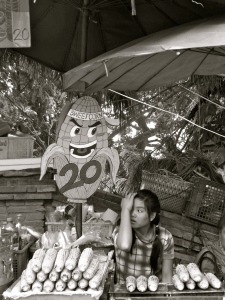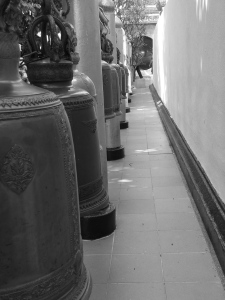Wats Going On?
The beaches of Phuket were nothing short of amazing but I was ready to explore another side of Thailand to get a better idea of the diverse culture and climate of the country. We headed up north for our last week to Chiang Mai. Chiang Mai is one of the oldest cities in Thailand and used to be the ancient capital. Only a few hours from the Myanmar (formerly Burma) border it is an amazing contrast from the white sand and blue waters. Surrounded by mountains and soaked in culture, Chiang Mai meaning “new city” was founded in 1296 so there is a constant mix of the ancient and the modern. It becomes apparent almost immediately when you drive from the airport into town. The traffic is hectic as motorbikes weave in and out. Tuk-Tuks and Songthaews putter along the roads as they pass by 700 year old moats and sections of what used to be part of the walled city. Terracotta shades of brick remnants outline the section of the old city and four gates still stand tall today. Thapae, the main gate, was the road that entered the city from the Ping River. Presently the square at the gate provides a space for outdoor markets and city festivals. The other gates in town are Chiang Mai gate, Suan Dok and Chiang Puerk gates.

City surroundings continue to remind visitors of the juxtaposition of days gone by and contemporary living. Chiang Mai has ancient temples sprinkled throughout the city. There are over 300 wats, or temples in Chiang Mai so you could take your whole time visiting on just temple tours. The wats add great visual interest so you can be dropping off your clothes at a laundry mat on one side of the street and across the road could sit a serene temple, a refuge from the hurried city atmosphere.
The most famous temple here is Wat Prathat Doi Suthep. The temple is usually referred to as just Doi Suthep, named for the mountain (doi) where it is located. Construction of the wat began in 1386 and I can only imagine how difficult it would have been to get there to worship since the roadway up the mountain wasn’t completed until the mid 1930’s. The temple is surrounded by Doi Suthep National Park and on the way to the summit you can hike and see two waterfalls, Huay Kaew and Mon Tha Than.
Once you arrive at the base there is still more of the mountain to climb. Above the parking area there are stairs lined with souvenir stalls and food carts. As you weave through the crowd of people and trinkets you’ll turn the corner to see the Naga Serpent steps leading up to the temple.
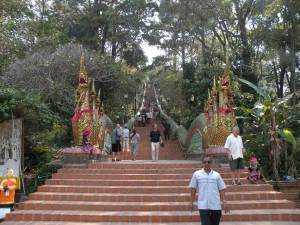
After climbing hundreds of stairs you reach the summit and then you realize that the work out was worth it. On a good day the views from Doi Suthep are breathtaking. Emerging through the lush vegetation of the park is a view of the city with flourishing hills and mountains beyond it. This is still a working temple and monastery so there are many buildings throughout the property for you to explore. We went earlier in the morning which is the best time not only to beat the crowds but also to avoid the hot sun.
There are bells and gongs scattered through the terraces and deep, haunting rings echo through the wat. It is believed that ringing the bells brings good luck. After walking around the first terrace you can enter into the upper courtyard to get a view of one of Thailand’s most sacred chedi. The golden pagoda sits in the center of the terrace, surrounded by golden statues of Buddha. Visible around the walls of the wiharn are over 40 murals depicting the life and teachings of Buddha. The wat for me is a must see while in Chiang Mai if anything just to get a glimpse of the unique Lanna style architecture. On your way out if you want to treat yourself to a nicer souvenir don’t forget to check out Orchid Jade Factory at the base by the car park.
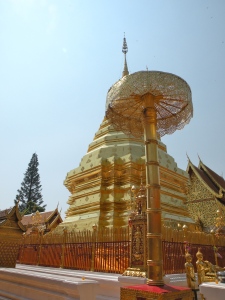
Here is a helpful website that shows a layout of Doi Suthep
http://www.fivethousandyears.org/
The White Elephant of Doi Suthep and our common White Elephant
The legend is a monk, Sumanathera had a vision that he was told to go look for a relic. He found a bone of Buddha and he took it to the King of Sukhothai. The king doubted the significance of the relic so he told the monk to keep it. The monk offered it instead to the Lanna King. Part of the relic was placed on the back of a white elephant and it carried the relic for three days through the jungle. The elephant reached the top of Doi Suthep, trumpeted three times, fell to the ground and died and this was a sign for where the temple would be built. Elephants are highly revered and it was common in Southeast Asia for monarchs to have these peaceful and powerful creatures. Because of their sacred status white elephants could not be put to work therefore becoming a costly gift. The white elephant became an idiom for a blessing and a curse and is now used today to reference an unwanted gift exchange or a tent of trinkets at a fair.
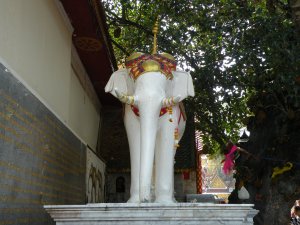
While in Chiang Mai I also took a day trip to Lamphun to see even more ancient wats located off the beaten path for tourists. Wat Hariphunchai and Wat Kukut are both located in Lamphun, which is south of Chiang Mai and is home to some of the oldest structures in Thailand. Wat Hariphunchai is one of the more famous temples of northern Thailand. When you enter there are two giant lions guarding at the gate. This was my favorite of all the temples we visited mainly because of the stunning reclining Buddha statues that are on the property. This temple dates back to before the 9th century and is built on the grounds of a former queen’s palace. There is a giant bronze gong there that claims to be the largest in the world. Wat Kukut (or Wat Chamadevi) is another example of a Lanna style temple founded in 755. Kukut has two ancient pagodas one marking the ashes of the Queen Chamadevi for whom the wat is named. It has a beautiful chedi that is one of the few examples left of Mon architecture. The structure was built to resemble a famous piece in Sri Lanka and has 60 Buddhas carved on all five stories. These temples show some great examples of how they have been renovated, maintained and expanded on through the years, preserving the thousand year old pagodas of stone among the new construction of golden statues.
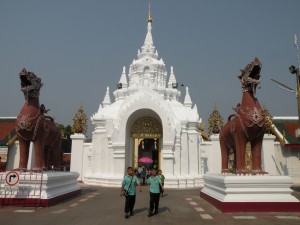
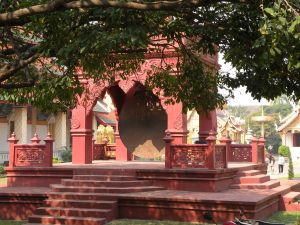

Temple Etiquette
Don’t forget that these wats are not only beautiful but they are a working religious space. Be respectful and mindful of places of worship. Here are a couple of quick reminders for when you visit.
Keep in mind that you need to be dressed appropriately when visiting the temples. If you have shorts on some larger temples can provide you with a covering but don’t count on it and bring your own.
When entering sacred spaces it is customary to remove your shoes at the door. If you are unsure there are usually piles of shoes that will indicate when as a reminder.
Women are not supposed to touch monks.
Be mindful of the people meditating and worshiping, don’t forget to turn off cell phones and keep photography from becoming a nuisance.
